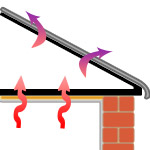Ceiling Insulation
Why Insulate your loft space
Put simply, un-insulated ceilings cost you money, and nowhere is this more noticeable than in your loft space. By insulating your loft to a depth of 270mm you can;
- Reduce your heating bills by as much as 20%.
- Lower the ‘wear and tear’ on your boiler.
- Positively impact Global Warming and Climate Change.
- Create a warmer and more comfortable home.
- Lessen the risk of ill health from damp and draughts.

Also insulating your property will increase it’s market value, as well as potentially reducing the amount of maintenance required for it’s upkeep.
Domestic energy efficiency ratings
Loft insulation is a crucial part of the Energy Efficiency Rating of the governments new home information packs (HIPS), which must be provided on each property for sale as of July 2007. Use the link below to make sense of these ratings:
Insulating the ceiling space
To further insulate your home it is possible to insulate the ceiling between floors, however if done correctly this task requires the complete removal and re-fitting of the plasterboard ceiling, and many will feel that the benefits (once loft insulation is added) are more than outweighed by the costs. As such most insulation of this type is added when the house is being completely renovated.
There are however a few occasions when insulation can be added to a ceiling space without going through the process of removal whole ceilings. If a room is situated over for example a garage, one can affix insulating ceiling tiles directly onto the plasterboard ceiling in the garage, to reduce heat loss from the warm internal room above into the cold garage. Although this might not give the most aesthetically pleasing finish, in a space like a garage the benefits of heat loss reduction far outweigh the ‘look’ of the ceiling.
Fire protection between floors
The benefits of insulating the space between floors do go beyond simply reducing ones heating bills. Most modern insulation with British Standards approval also meets the fire resistance requirements of the building regulations – which stipulates that in a fire situation, the floor will not collapse for at least 30 minutes.
This means there are times when one must ensure that ceilings are insulated and fire proofed, for example, when a two (or more) storey house is converted into flats.
- Always consult your local council’s planning department if you have any doubts with regards to fire safety.
Loft insulation materials
The materials available to insulate the floor of a loft space are available in two distinct formats; Matting or Rolls, and Loose-fill. Both do the job equally well, however they do vary in their application and ease of installation.
As for the materials themselves, the choice is huge and varies from traditional materials such as fibre glass and mineral wool through to organic materials such as sheeps wool and cellulose fibre.
It is also possible to apply Polyurethane Foam directly onto the underside of the roof. This method requires a professional installation due to the nature of the products involved, however it’s a solution which is ideal for applications where the floor of the loft is unsuitable for other forms of insulation. For example, converted lofts or old (pre 1930) Grade I & II listed buildings.
Grants to help pay for insulating your loft
There are a range of grants and offers available to help you implement energy saving measures in your home. Most of the grants and offers you can benefit from are provided by three main groups.
The Government
The UK Government funds schemes providing up to £2,500 to households on certain benefits to improve their heating and energy efficiency. In England the scheme is known as Warm Front, in Northern Ireland it is Warm Homes, in Scotland Warm Deal and in Wales it is the Home Energy Efficiency Scheme.
Energy suppliers
The Government's Energy Efficiency Commitment means energy suppliers of a certain size operating in Great Britain are obliged to help achieve targets for improving home energy efficiency. The suppliers therefore provide a range of offers which significantly reduce the cost of installing energy efficiency measures. What's more, you can take up offers from any of the energy companies, regardless of who supplies your gas and electricity.
Local authorities
Local authorities provide grants and offers for local residents to install energy efficiency measures in their home.
What the Building Regulations say
When considering insulation for your home, and especially if you are renovating and/or adding an extension to your property, you must adhere to the current Building Regulations.
Part B (Fire Safety), Part C (Site Preparation & Resistance to Moisture) and Part L (Conservation of Fuel & Power) all make clear references to the use of insulation.
- You must ensure that any materials you use to insulate your home have met the relevant standards required.
- Any building work you carry out must meet the requirements, particularly for fire safety.
- Due to the positive environmental impact of insulating your home, you may be eligible for a grant to help you pay for the necessary work to be carried out.
- Building Regulations Part B: Fire Safety
- Building Regulations Part C: Site Preparation
- Building Regulations Part L: Energy Conservation
- Full guide to the building regulations
Further information and useful links
- Making structural changes to your property
- Successfully damp proofing your home
- More walls and ceilings topics
- Building works topics
- Asbestos information & advice
- Find a Insulation Installer near you
- Find a Builder near you
- National Insulation Association
- Energy Savings Trust (est.org.uk)
- Cavity Insulation Guarantee Agency (ciga.co.uk)
- Party Wall Guidance (rics.org)
- Impact of the Party Wall Act 1996 (communities.gov.uk)
Site Pages
Featured Articles





